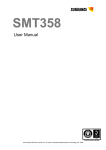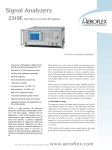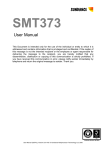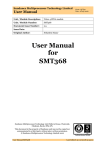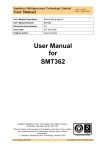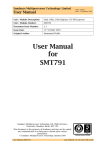Download SMT338 User Manual - Sundance Multiprocessor Technology Ltd.
Transcript
SMT338 User Manual User Manual (QCF42); Version 3.0, 8/11/00; © Sundance Multiprocessor Technology Ltd. 1999 Version 1.5 Page 2 of 19 SMT338 User Manual Revision History Date 1 Oct 1999 2 Dec 1999 Comments Engineer E Puillet. Initial Release Modification of Reconfiguration the FSM for the FPGA E.Puillet Version Version1.0 Version1.1 06 Jan Clarification of the FSM and explanations for E.Puillet 2000 the FPGA Configuration and Reconfiguration. Version 1.2 05.12.00 Description of the Installation and configuration E.Puillet of the SMT338 Version 1.3 20.12.00 Addition of drawing for 50-way connector E.Puillet pinout and of reference for mating 50-way SCSI connector Version 1.4 02.05.01 Modification of table 3 Pin out to match the E.Puillet change of connector on the SMT338 (Female to Male). Modification of explanations about the reconfiguration in real time. Version 1.5 31.03.04 Modification of paraghaph 3.1 section 3.1.1 E.Puillet DONE is on LED 6 Version 1.6 This Document is intended only for the use of the individual or entity to which it is addressed and contains information that is privileged and confidential. If the reader of this message is not the intended recipient or the employee or agent responsible for delivering the message to the recipient, you are hereby notified that any dissemination, distribution or copying of this communication is strictly prohibited. If you have received this communication in error, please notify sender immediately by telephone and return the original message to sender. Thank you. Version 1.5 Page 3 of 19 SMT338 User Manual Table of Contents Revision History.......................................................................................................... 2 Table of Contents ....................................................................................................... 3 List of Figures ............................................................................................................. 4 List of Tables .............................................................................................................. 4 Scope ......................................................................................................................... 4 1. Technical description........................................................................................... 5 1.1. Differential lines............................................................................................ 6 1.2. Sundance Digital Bus (SDB) ........................................................................ 8 1.3. SMT338-DSP Communication channels ...................................................... 8 1.4. Sundance Datapipe Link .............................................................................. 9 1.5. FPGA ......................................................................................................... 10 2. Installation ......................................................................................................... 10 3. Configuration ..................................................................................................... 11 3.1. Hardware Sequence of events ................................................................... 11 3.1.1. 3.2. At power-up......................................................................................... 11 FPGA Reconfiguration ............................................................................... 13 3.2.1. Once configured.................................................................................. 13 3.3. FPGA Reconfiguration in real time ............................................................. 13 3.4. Software tools ............................................................................................ 14 4. SMT338 Versions .............................................................................................. 15 5. Interface ............................................................................................................ 16 Version 1.5 Page 4 of 19 SMT338 User Manual List of Figures Figure 1: SMT338 Block diagram ............................................................................................. 5 Figure 2: LVD Familly sets standard ........................................................................................ 6 Figure 3: Global Clock Buffers assignments in the Virtex ........................................................ 7 Figure 4: FPGA-DSP Communication Channels ...................................................................... 9 Figure 5: Global Reset routing. Use of FPGARESET as a global reset for designs............... 12 Figure 6: FPGA reconfiguration ............................................................................................. 13 Figure 7: SMT338 Layout ........................................................................................................ 16 Figure 8: SCSI Connector Front View (Male)......................................................................... 17 List of Tables Table 1: Virtex-Differential I/Os Combinations ...................................................................... 15 Table 2: SMT338 connector reference table............................................................................ 16 Table 3: Differential Signals –50 WAY High-density cable Pins............................................. 17 Table 4: 40 Way SDB Connector Pins ..................................................................................... 18 Table 5: JTAG Connector ........................................................................................................ 19 Scope This document describes the architecture, the function, the use and the interface considerations for the SMT338. This document is intended for both the users of the SMT338 and the designer who is interested in designing the FPGA provided on the Board. Version 1.5 Page 5 of 19 SMT338 User Manual 1. Technical description 50 way Density Diff_Con1 High 50 way Density Diff_Con2 High Differential Line converters Differential Line converters DIFF1 DIFF2 Comm-Port 1,4,2,5 40 way SDB_Con1 IDC SDB 1 FPGA Control Bottom Primary Connector Global Bus Connector D[31:0] XCVxxxxBG352-4 40 way SDB_Con2 IDC A[30:0] SDB 2 IIOF2 Top Primary Connector H1 Comm-Port 50MHz Oscillator Config Control Comm-Port 3 Ctrl Config D[7:0] Comm-Port 3 Configuration Logic CPLD Figure 1: SMT338 Block diagram Comm-Port Version 1.5 Page 6 of 19 SMT338 User Manual Figure 1 shows the block diagram of the SMT338 I/O module. The following section describes the SMT338 from a user’s point of view. Reference is made to the different blocks of Figure 1 in the next Figures. 1.1. Differential lines Differential signalling is the mechanism of choice when long-distance connections from a PC to the outside world or/and high bandwidth requirements need to be satisfied. The SMT338 provides the user with differential pairs connected to two on-board 50way headers on one end and to a Virtex FPGA on the other end to offer an extremely flexible differential signalling solution. With the ability to interface directly to RS422, RS485, Low Voltage Differential Signalling (LVDS), and Bus LVDS (BLVDS) known as well under Multipoint LVDM differential I/O standards, the SMT338 supports input, output and I/O signalling. Point-to-point and multidrop transfers are achievable with up to 40 pairs for RS422, RS485 at 32 Mbps or LVDS at 400Mbps. Figure 2 describes the different types of transfer. LVDM for multipoint buses. More than one driver and one receiver on the line LVDS for point-to-point(1) and multidrop(2) connections. (1)One driver and one receiver on the line (2)One driver and more than one receiver on the line. Figure 2: LVD Familly sets standard Version 1.5 Page 7 of 19 SMT338 User Manual The SMT338 provides 32 differential input pairs and 8 differential output pairs on-board. The 32 receiver pairs have 2 of their TTL outputs connected to two Global clock buffers of the Virtex to be able to use its DLL capabilities. The Virtex provides four independent Global Clock Buffers, which allow the use of 4 programmable DLLs to produce waveforms with a wide range of frequencies and duty cycles. Figure 3 is a detailed view of the Differential signal connections to the FPGA and the clock buffers assignments. 50 way High Density Diff_Con1 8 30 2 15 DIFF1 DIFF1 2 30 TTL Diff Conv 4 50 way High Density Diff_Con2 Clk 1 Gnd 5 5 Gnd TTL 5 5 Diff Conv 15 Clk 2 DIFF2 1 BANK0 8 1 4 DIFF2 BANK1 FPGA XCVxxxx BG352 BANK5 BANK4 BoardClk SDB A Clk A SDB B Clk B 22 40 way IDC SDB_ConA Figure 3: Global Clock Buffers assignments in the Virtex 22 40 way IDC SDB_ConB Version 1.5 1.2. Page 8 of 19 SMT338 User Manual Sundance Digital Bus (SDB) The four 40-way miniature IDC connectors’ primary function is to provide bi-directional 16bit data paths between TIMs with data transfer rates over 200 Mbytes/s. Data rates of 200 Mbytes/second through a connector have been achieved using a ground interlaced signal cable. Each high speed Sundance Digital Bus (SDB) Interface can transfer 16-bit data, to and from the TIM, at such a transfer rate. 400 Mbytes/Second Data rates can be reached using in parallel 2 (SDB) Interfaces to send a 32-bit data every clock cycle at 100 MHz The SDB Interface packs the 16-bit data transmitted into a 32-bit Word and stacks them into a FIFO ready to be used. The transmission can be fully bi-directional. Many of Sundance TIM modules are being designed with this interface. A SDB Interface is available from Sundance Multiprocessor Technology IP Centre. Alternatively, the Sundance Digital Bus links can be extended to external interconnection by connecting them to the SMT373 mezzanine card. With this card, TTL signals are converted to Low-Voltage Differential signals and can connect two systems several meters apart. It provides two bi-directional 20-bit channels that can transfer up to 2 Gbytes/s through forty SN65LVDM176 transceivers. Each channel provides 16 bit of data, a clock and a clockenable signal with their direction controlled by one signal. Two other signals can be used for the bus arbitration in a bi-directional application. The direction of each of them can be controlled independently. All the signals controlling the direction are connected to the SMT338 FPGA through the connectors and so can be controlled by software. 1.3. SMT338-DSP Communication channels The global bus or Comm-Port 0,1,2,34,5 or 6 are communication channels of the SMT338 used to interfaced to T.I.’s DSP processors. The ‘C4x Protocol defines Byte-wide links which can theoretically transmit at 20Mbytes/second asynchronously between TIMs. The Global Bus is only available when the SMT338 is connected onto the SMT350PB motherboard. The SMT350PB provides a non-blocking global bus interconnection between any source TIM site and any other destination TIM site. It provides a sustainable throughput of 50 Mbytes/s Version 1.5 Page 9 of 19 SMT338 User Manual between any of the module sites even with three modules accessing the same destination module. Access to the PCI bus takes place through TIM site 1. Please see our Web Site at http://www.sundance.com/ Figure 4 shows the various dedicated DSP communication channels available on the SMT338 for inter-TIM data transfers. Configuration Logic CPLD Comm-Port 3 Config Control Comm-Port 3 Global A[30:0] FPGA Global D[31:0] Comm-Port 0 XCVxxxx BG560 10 Global CTRL H1 Bottom Primary Connector 8 4 Global Bus Connector Top Primary Connector Comm-Port 3 Ctrl Config D[7:0] IIOF2 Comm-Port 1245 Figure 4: FPGA-DSP Communication Channels For developers who want to interface a SMT338 to a C4x or C6x TIM like the SMT302, SMT331 or SMT332 via Comm-Ports or the Global Bus, a Comm-Port interface and a Global Bus interface are available from Sundance Multiprocessor Technology IP Centre. 1.4. Sundance Datapipe Link The Comm-Port connections provided on the SMT338 can be used as Sundance Datapipe Links for fast data transfers between SMT338-SMT338 or ‘C6x TIM based boards like the SMT335. An SDB interface is used and offers up to 100 MHz on copper and 50 MHz on flat-ribbon cables like the FMS used on the Sundance range of carrier boards. Version 1.5 1.5. Page 10 of 19 SMT338 User Manual FPGA The FPGA is to be configured over Comm-Port 3 via the CPLD. The configuration bitstream is sent by a ‘C6x or ‘C4x processor. This feature will allow a system to dynamically change the FPGA firmware. The configuration LED indicates that configuration is complete. The FPGA drives 4 LEDs, and is connected to it’s own local oscillator package. The FPGA firmware will be user defined, and can be done on demand. Typical functions that can be implemented in the FPGA are: • Full bi-directional global-bus interface • Full bi-directional Comm-Port interface • Bi-directional SDB Interface • RAM, FIFOs, Dual port RAMs up to a total of 16K Bytes • Communication protocols • DSP pre-processors • Any digital function that will fit in this size device The SMT338 TIM can typically be used to interface with a SMT338 Frame Grabber over the SDB connectors. The SMT338 can then perform customer specific data formatting before sending it to a nearby C40 TIM via Comm-Port. Due to the parallel nature of an FPGA it is well suited to handle multiple high-speed I/O lines. The FPGA can then provide a cleaner bus-interface to the associated DSP processors. 2. Installation The minimum system requirements needed to run a SMT338 on a PC is a C4x TIMbased carrier board and a C4x or C6x TIM with at least a Transmit Comm-Port (Comm-Port 0,1 or 2) at Reset. The goal is to connect one of the processors Comm-Port to Comm-Port 3 of the SMT338. Follow these steps to install the SMT338 module on a Host system: 1. Remove the carrier board from the host system. 2. Place the SMT338 module into one of the TIM sites on the carrier board. Version 1.5 Page 11 of 19 SMT338 User Manual 3. Make sure the that the board is firmly seated, then provide the 3.3V to the board by screwing the SMT338 on the two main mounting holes with the bolts and screws provided with the board. 4. Fit the processor-based board on the carrier board. To do so, please follow the installation procedure of that specific board. In the case of a SMT320 carrier board, the C4x or C6x board MUST be placed on the first TIM slot (TIM slot 0) of the SMT320. 5. Connect at least Comm-Port 3 of the SMT338 to one of the transmit Comm-Port (at Reset) available on the Processor-based board. 6. Connect the SDB links as well if required by your application. 7. Replace the carrier board in the host system. 3. Configuration The configuration of a SMT338 can only occur when a Global reset has been asserted to the TIM. The carrier board on which the SMT338 TIM is plugged asserts its Global Reset, often called TISRESET, at power up or when requested by any software running on the host (Like Sundance 6000 Server). The FPGA configuration is done by a software routine running on a host, or a ‘C6x or ‘C4x processor plugged on a carrier board root site. The Virtex bitstream must be downloaded via Comm-Port 3 of the SMT338 which is handled by theCPLD. After configuration, the CPLD gives the hand to the FPGA, which becomes the owner of Comm-Port 3. The CPLD does the handshake with the Comm-Port and communicates with the FPGA as well. The following description is referring to Figure 7. 3.1. Hardware Sequence of events 3.1.1. At power-up. 1) The CPLD polls Comm-Port 3 until it receives the keyword 0xBCBCBCBC. (WAITFORCMD State) 2) On receiving the start-of-bitstream keyword 0xBCBCBCBC, The CPLD reads out the FPGA bitstream from Comm-Port 3 and configures the FPGA (CONFIG State). 3) The FPGA releases its DONE pin when the configuration phase is finished. At this time LED6 goes on (LED6 is directly driven by DONE). Then, the FPGA completes its startup sequence and the design downloaded is now ready to start. Version 1.5 Page 12 of 19 SMT338 User Manual • If the design inside the FPGA instantiates Comm-Port 3: it must be kept reset while the bitstream finishes to be downloaded. To do so, use the FPGARESET pin as a global reset for the Comm-Port interface in particular and for the whole design in general. FPGARESET is a bi-directional active low signal. The CPLD asserts FPGARESET low until it receives the end-ofbitstream word BCBCBC00 defining the end of the configuration process and enters into an IDLE State waiting for an interrupt (general TISRESET from the PCI or FPGARESET coming from the FPGA this time). • If the design inside the FPGA doesn’t instantiate Comm-Port 3: The CPLD asserts FPGARESET low until it receives the end-of-bitstream word 0xBCBCBC00 defining the end of the configuration process and enters into an IDLE State waiting for an interrupt (general TISRESET from the PCI or FPGARESET from the FPGA). Meanwhile, the FPGA design can start if it doesn’t use FPGARESET as a global reset. (but a good practice is to use FPGA RESET as a global reset). Top Primary Connector FPGA XCVxxxxxBG352 Config Control FPGARESET Com-Port 3 Ctrl Config D[7:0] TIS_RESET Com-Port 3 Com-Port 3 Data TIS_RESET FPGARESET Logic OR TIS_RESET Configuration Logic CPLD Figure 5: Global Reset routing. Use of FPGARESET as a global reset for designs. Version 1.5 3.2. Page 13 of 19 SMT338 User Manual FPGA Reconfiguration The following description is referring to Figure 8. 3.2.1. Once configured. When a TISRESET is received by the SMT338, the CPLD and the FPGA are reset. 4) The CPLD owns Comm-Port 3 and can configure the FPGA with a new bitstream (repeat step 2). 5) The CPLD can leave Comm-Port 3 available to the FPGA and enter an Idle state on receiving the command BCBCBC00. Figure 6: FPGA reconfiguration 3.3. FPGA Reconfiguration in real time The SMT338 can be reprogrammed on-the fly by sending a new bitstream to the Virtex FPGA. It is possible to reconfigure the Virtex dynamically by sending a reconfigure command to it. The circuit recognizing a reconfiguration request must be implemented in the FPGA, so any user-defined command can be sent over a Comm-port for instance. An example design is provided in the software package for the SMT338 (SMT6338). Version 1.5 Page 14 of 19 SMT338 User Manual The design makes use of a Comm-port to pass the reconfigure command to the SMT338 FPGA and waits for a 1 on the LSB of this Comm-Port. If another Comm-port than Comm-port 3 is used, the pins corresponding to Commport 3 on the FPGA must be tied to “1” in the FPGA (As designed in the reconfiguration example design) The following description is referring to Figure 8. 6) The FPGA reads the command and then warns the CPLD by sending an interrupt (FPGARESET low) that it decoded a reconfigure command. The FPGA goes into a RESET state and leaves Comm-port 3 available for the CPLD. (in case Commport3 is used by the design). 7) On receiving the FPGARESET interrupt, the CPLD goes into the WAITCMD State and polls Comm-port 3 for a keyword. (0xBCBCBCBC or 0xBCBCBC00) 8) On receiving the keyword, • If it is the end-of-bitstream keyword 0xBCBCBC00, the FPGA DOES NOT get reconfigured, the CPLD leaves Comm-port 3 available for the FPGA and enters into an IDLE state to wait for the next interrupt. • If it is the start-of-bitstream keyword 0xBCBCBCBC, repeat step 2 to 3). 3.4. Software tools The SMT6338 is a suite of software support for the SMT338. It contains: • A library of IP cores: a Comm-port Interface and a SDB interface. • Design examples of Comm-Port and SDB applications. • The pin allocation file for the Virtex/E: VIRTEX_TOP.ucf. • The conversion software needed AFTER a bitstream has been generated to format the bitstream. Some additional software is required: • A CAD platform to create a schematic or VHDL design. • A simulator to simulate the hardware designs. • Xilinx Place & Route software such as M2.1i. • Texas Instrument C compiler or 3L parallel C compiler. Version 1.5 Page 15 of 19 SMT338 User Manual The bitstream that is used to configure the Virtex/E on the SMT338 is built using Xilinx Design implementation tools for FPGAs such as M3.2i and the Sundance conversion software bit2dat.exe. Follow these steps to build a bistream that can be executed on the SMT338: 1. With the Xilinx tools, select your design available in edif format (filename.edf). 2. Target the constraint file provided with the SMT338 to map your design to the Virtex/E ’s I/O pins (comment out all the I/Os that your design doesn’t use) 3. Run Xilinx Design implementation tools. 4. Next the bitstream is generated (Entityname.bit). The bitstream is a binary image of the VHDL core. 5. Format the Entityname.bit to an Entityname.dat file with the standalone application bit2dat.exe. To do so, you need to modify the Bit2dat.dat file. • Place the file Entityname.bit in the folder containing the executable file Bit2dat.exe. • Edit the file Bit2dat.bat file. • Replace “bit2dat bitfilename bitfilename ” by “bit2dat Entityname Entityname”. Note that the extension “.bit” is not necessary. • Save and double click the bit2dat.bat file. The executable is called and generates a “.dat” file. 6. At this point the hardware core is ready for implementation in an application. 7. With an application running on the Processor-based board to which the SMT338 is connected to, or from a Windows based application, send the file Entityname.dat through the Comm-port connected to Comm-Port3 on the SMT338. 4. SMT338 Versions The SMT338 comes under 2 standard versions, highlighted in red in Table 1. The Virtex fitted is a XCV300-4. SMT338 Virtex XCV300 XCV 150 XCV 200 RS422 SMT338-422 SMT338-422 SMT338-422 RS644 SMT338-644 SMT338-644 SMT338-644 Differential I/Os Table 1: Virtex-Differential I/Os Combinations Version 1.5 Page 16 of 19 SMT338 User Manual 5. Interface P2 P2 CPLD Voltage Regulator 95144 SDB Conn2 SDB Conn1 Osc VIRTEX FPGA BG352 Driver Receiver Receiver 5 LE DS Driver Receiver Receiver Receiver J T A G DIFF2 Receiver DIFF1 Receiver 50-way high density connecto r Receiver XCVxxx 50-way high density connecto r JTAG Connector P1 P1 Figure 7: SMT338 Layout Table 2 shows the Physical Layout of the SMT338, indicating the external connectors with their location and numbering. Connector definitions are as follows: SDB 1,2 DIFF1, DIFF2 : Digital Data & Clock Input /Output Signal – Sundance Digital Bus High Density ODU connector A (40-way High Density IDC Connectors). Differential Signals –50 WAY SCSI Male connectors. Solder Pins. JTAG : JTAG Signals – 6-way connector. P1 : Top Primary connector. P2 : Bottom Connector. (Bottom Primary and Global Expansion Connectors) Table 2: SMT338 connector reference table Version 1.5 Page 17 of 19 Pin SMT338 User Manual Function +, TTL and Ground Pins Drivers Pins Receivers Pins Ground Pins 1,26 TTL4/Gnd 2,27 TTL2/TTL3 3,28 TTL0/TTL1 4,29 Gnd/Gnd 5,30 Output Data 3 6,31 Output Data 2 7,32 Output Data 1 8,33 Output Data 0 9,34 Input Data 15 10,35 Input Data 14 11,36 Input Data 13 12,37 Input Data 12 13,38 Input Data 11 14,39 Input Data 10 15,40 Input Data 9 16,41 Input Data 8 17,42 Input Data 7 18,43 Input Data 6 19,44 Input Data 5 20,45 Input Data 4 21,46 Input Data 3 22,47 Input Data 2 23,48 Input Data 1 24,49 Input Data 0 25,50 Gnd/Gnd Table 3: Differential Signals –50 WAY High-density cable Pins 1 25 26 50 Figure 8: SCSI Connector Front View (Male) Version 1.5 Page 18 of 19 SMT338 User Manual A mating connector can be found from HARTING. The mating connector is a 50-way SCSI Female connector, solder cup. The order code is 60 03 050 5180. Function Pin Pin Function GND 2 1 CLK GND 4 3 D0 GND 6 5 D1 GND 8 7 D2 GND 10 9 D3 GND 12 11 D4 GND 14 13 D5 GND 16 15 D6 GND 18 17 D7 GND 20 19 D8 GND 22 21 D9 GND 24 23 D10 GND 26 25 D11 GND 28 27 D12 GND 30 29 D13 GND 32 31 D14 GND 34 33 D15 CTRL1 36 35 USER_0 CTRL2 38 37 WEN CTRL3 40 39 USER_1 Table 4: 40 Way SDB Connector Pins Version 1.5 Page 19 of 19 Function Pin VCC 1 GND 2 TCK 3 TDO 4 TDI 5 TMS 6 Table 5: JTAG Connector SMT338 User Manual



















